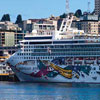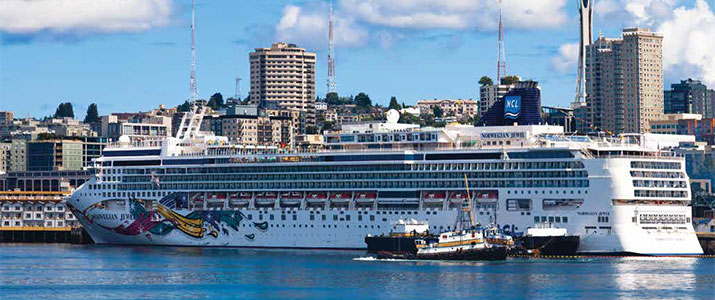
Bringing Mixed Results
Regulations and money are all part of maritime security
- By Vicki Contavespi
- Jul 01, 2014
 Maritime ports are complicated, amorphous creatures; their
sheer breadth is staggering. In the United States alone, there
are more than 3,700 cargo and passenger terminals with
more than 1,000 harbor channels running along roughly
12,800 miles of coastline. The Port of Houston, not even the
biggest, in fact, has 28 miles of coastline.
Maritime ports are complicated, amorphous creatures; their
sheer breadth is staggering. In the United States alone, there
are more than 3,700 cargo and passenger terminals with
more than 1,000 harbor channels running along roughly
12,800 miles of coastline. The Port of Houston, not even the
biggest, in fact, has 28 miles of coastline.
According to the U.S. Coast Guard, there are 361 major ports with port authorities
as the others are governed by various state and local public entities, portnavigation
districts and municipal port departments. Port authorities’ purview
includes airports, bridges, tunnels, commuter rail systems, inland river or shallow
draft barge terminals, industrial parks, Foreign Trade Zones, world-trade centers,
terminal or short-line railroads, shipyards, dredging, marinas and other public recreational
facilities. They compete amongst themselves because, ultimately, ports
are engines of commerce…big engines of commerce.
Of the Business Roundtable’s most recent numbers (2012), international trade
is responsible for approximately 38 million American jobs, including those who are
employed in exporter/importer-related businesses and support industries throughout
the United States. And, the airport and maritime security budgets are expected
to grow to roughly $40 billion by 2018, up from $22.28 billion in 2013, according
to market research reports.
An attack on a major U.S. port would have serious ramifications for the entire
globe because, according to U.S. Census statistics, the value of international goods
shipped through U.S. seaports in 2011 was $1.73 trillion, representing more than
11 percent of the total U.S. GDP. This does not include the value of domestic cargo
moved through seaports (estimated to be one billion tons annually), the value
of cargo-handling services or cruise-industry impacts.
Acting, not Reacting
When the U.S.S. Cole was attacked in 2000, it became apparent that ships and
ports needed more protection, especially against unorthodox threats. But when
9/11 happened, a major sea change occurred: No longer could ports be defensive
and laid back—they had to get proactive, and fast.
Two programs, the Maritime Transportation and
Security Act (MTSA) and the International Ship and
Facility Security (ISPS) Code, for international voyages,
were put into law in 2002 and 2004, respectively.
The ISPS Code, introduced by the United Nations
in conjunction with 108 countries, and the MTSA require
vessels and port facilities to conduct regular vulnerability
assessments and develop evolving security
plans that include passenger-, vehicle- and baggagescreening
procedures; security patrols; the establishment
of restricted areas; initiation of personnel-identification
procedures; access control measures and/or
the installation of surveillance equipment. However,
not all vessels and port facilities in the Unites States
are affected by the MTSA regulations. Only those sectors
considered to have a high risk of involvement in
an incident are affected by this law.
Herman Gomez, a maritime security consultant
and the former director of the Office of Training,
Planning and Development of the Security/Police
Division at the Port of Miami, said that the most important
part of these codes is the requirement that
each port create and maintain a thorough security
plan, detailing everything that a port has, including
how it is organized, how many people are dedicated
to security, what kind of communications the officers
use, what kind of training they give and how often it
is done. Also mandated is maintaining a contingency
plan in case of disaster.
“One problem with the security plan is that sometimes
a port implements a new feature but it isn’t reflected
in writing on the plan because of lack of time
or sloppiness,” Gomez said.
These omissions could severely impact procedures
during an incident. However, his major concern is
that the codes require every major international seaport
to secure its access control by water, and it is
nearly impossible for all ports and marinas to have
surveillance equipment or, at the very least, a patrol
boat in the water.
“Major ports do this as required by the code,” Gomez
said. “Some ports don’t have the money to comply
with these regulations.”
The Port of Miami, one of the largest in the world,
spent some $50 million to comply with security requirements
for both the passenger and cargo areas.
Smaller ports do what they can, but they remain the
soft underbelly of the maritime security world.
Paving a Fast Lane for Access Control
The Transportation Worker Identification Credential,
or the TWIC program, mandated that the DHS issue
an ID card with biometrics to control access to
secure areas of ports or on ships. Meant for Coast
Guard-credentialed merchant mariners, port-facility
employees, long shore workers, truck drivers and others
requiring unescorted access to secure areas of
maritime facilities and vessels regulated by MTSA,
the Transportation Security Administration (TSA)
had a preliminary deadline of six million maritime
workers, all of whom were to have cards by 2004. It
didn’t happen. As of April 14, 2014 the U.S. Coast
Guard reported that total enrollment was 2.95 million
with 1.99 million active cards. On them is the person’s
name, the card’s expiration date, a digital photo and
two fingerprints.
“The West Coast’s Long Shore Union won’t put their cards into the readers,” said Edward
Madura, security chief of the
Port of Everett, Wash. “They feel it’s
an invasion of privacy.”
This seems a vacuous stance, since
even smartphones use biometric fingerprints.
Moreover, these same longshoremen
could shut down commerce and
leave a facility unable to move its goods.
Bureaucracy also bedevils port-security
professionals.
“It took us a year to get the TSA to
realize that sometimes TWIC cards are
illegitimate,” Madura said. “They told
us operators that we couldn’t take action
on someone who tried to illegitimately
use a valid TWIC. We can kick
them off the facility, but we cannot call
the police or take the card.”
What they can do is fine them
$10,000 per person, per incident, but if
that fraudulent user happened to have a
malevolent goal, too bad—once a dirty
bomb or some other sort of WMD has
reached a port, it’s already too late.
The TWIC system has another major
oversight problem—it does not tap
into the national criminal database. So,
if a card holder has a felony, is a drug
dealer or simply had their driver’s license
revoked, they would still be able
to get a card.
“TWIC is a federal requirement,
and it’s good, but some seaports require
other types of ID in addition to
the TWIC, and that is working better,”
Gomez said.
It makes a lot of sense, especially
because the AAPA has major concerns
about which ports will or will not use
the reader, the inflexibility of the risk
analysis methodology and the lack of
tailoring reader requirements for the
individual circumstances of each port
or facility.
A Fast Lane for Ca rgo that’s
Running out of Money
Other major initiatives stemming from
9/11 are the Customs-Trade Partnership
Against Terrorism (C-TPAT) and
the Container Security Initiative (CSI),
which are voluntary supply-chain security
programs headed up by U.S. Customs
and Border Protection (CBP).
They focus on improving the security
of the foreign ports and private sector’s
supply chains vis-à-vis terrorism.
Companies that obtain a C-TPAT
or a CSI certification must have a
documented process for assessing and
alleviating risks throughout their international
supply chain. The plan allows
companies to get quicker cargo processing
and fewer Customs examinations.
Lack of funding is a major bugaboo
of this program, but security
managers know they need to have it in
order to keep goods flowing.
“CBP is doing its job; there are Xray
machines in most major seaports
and smaller ones use two antennae with
CBRNE sensors, which the cargo container
passes through,” Gomez said.
“Many are private ports, meaning the
land belongs to the government and the
port operation belongs to the private
sector. They try to save money as much
as they can, and some international
ports are lagging behind.”
At this point, roughly 12 percent of
all international cargo shipments are
inspected in the United States. However, there are about 60 CSI-certified
ports in Europe, Latin-America and
Africa that are well-equipped, too, according
to Gomez. These ports handle
about 80 percent of the cargo entering
the United States.
The CSI and C-TPAT programs are
considered to be excellent, but, according
to these experts and the AAPA, evidence
collected by the DHS Office of
Inspector General reveals that CBP and
the Domestic Nuclear Detection Office
don’t have any plans for the continuing
maintenance, replacement or funding
of these machines; nor do the ports feel
they should pay for a program initiated
by the federal government.
Upgrading Technologies
In the 10 years since the ISPS and
MTSA codes have been in place, security
at U.S seaports and aboard vessels
has improved tremendously, and so has
technology. Smaller ports are doing
what they can to upgrade to the latest
360-degree surveillance technologies,
and install radar and other sensors in
terminals and around their perimeters.
Cruise ships, too, are upgrading both
onboard and in terminals.
Roughly 22 million people took a
cruise last year. Cruise lines have separate
laws from ports and according to
Steve Donovan, Oncam Grandeye’s director
of sales for the Americas, “A lot
of the video guidelines were so subjective
that the industry hasn’t implemented
any video standards.”
Donovan is in charge of the Royal
Caribbean work with Oncam Grandeye.
He indicated that Royal Caribbean was
a leader because they took a proactive
approach to security by arming each of
its 20 ships with more than 700 cameras.
“For years, cruise lines didn’t want
to discuss video security,” said Donovan.
“Now, they need to prove they
are safe for customers, and they are
upgrading to 360-degree technology,
which saves them money because it requires
fewer cameras and less storage
space while giving them better visibility
as to what is happening onboard.”
Ironically, the biggest concern for
some ports is the cruise ships themselves,
because when a floating city
comes into port it opens up a whole
new can of worms.
“Cruise ships bring security and
operational concerns exponential to
anything else in the marine industry,”
Madura said.
That may be, but it also brings in a
huge pot of gold to the ports and the cities
they visit. According to Cruise Market
Watch, the total worldwide cruise
industry is estimated to be worth $37.1
billion, a 2.3 percent increase over 2013.
“Getting the cruise lines brings in
more jobs for people onboard, in parking
facilities and building new infrastructure,”
Donovan said.
What are needed, though, are stronger
security standards, a sentiment that
is echoed throughout the entire maritime
world.
This article originally appeared in the July 2014 issue of Security Today.